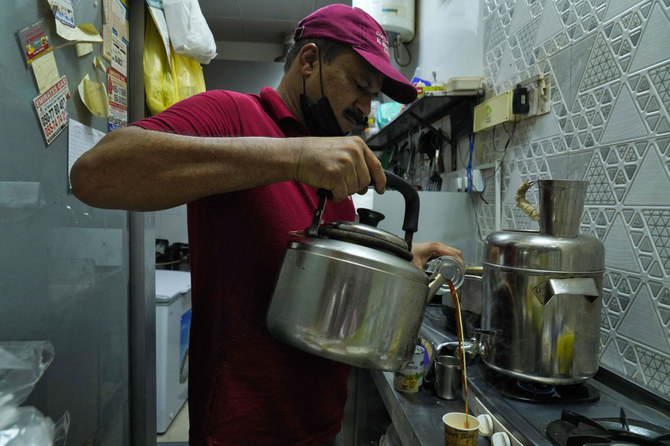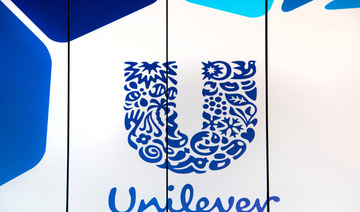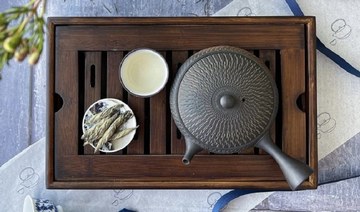DUBAI: From Mustafa Moeen’s spot behind the counter, he sees the many faces of Dubai. They come — tired, hungry, stressed out — for a respite and a cup of karak.
Laborers stop on the way to work. Cab drivers linger after long shifts. Emiratis cruise by on midnight joyrides. A cup of milky sweet tea to ease the burden of the day, customers say, long priced at just 1 dirham, a bit less than 30 US cents.
But now, as supply chain shortages and Russia’s war on Ukraine lead to price spikes on everything from breakfast sandwiches in Manhattan to chicken tinga in Mexico, Dubai tea sellers are bumping up prices of what’s informally considered the national drink of the United Arab Emirates. Moeen says he had no choice but to raise the price to 1.50 dirhams, or just over 40 cents.
“Everything got more expensive for us — milk, sugar, tea bags. Even the price of cups doubled,” Moeen said from the one-room storefront in Satwa, a neighborhood bustling with South Asian workers on rickety bicycles that can feel a world away from Dubai’s flashy skyscrapers. “We also have to survive.”
For nearly two decades, karak — an elixir of sugar, dehydrated milk and cardamom-infused tea — has largely been the same price, just one nickel-plated steel dirham coin. A dirham is worth 100 fils.
“It’s not about the 50 fils. They are making small, small changes,” said Zeeshan Razak, an accountant from Kerala, India, sipping tea with his colleague. “We are concerned about what it means.”
It was one of the rare treats that a dirham could buy in Dubai, which draws both the world’s richest people and legions of low-paid migrant workers.
“It’s part of its brand that it costs 1 dirham,” said Abdulla Moaswes, a Palestinian karak aficionado raised in the UAE who’s known for his scholarship on the tea. “People stockpile the coins so they always have one on hand.”
But rising inflation has taken a toll. The price of another sweet staple in Dubai long worth 1 dirham, the McDonald’s soft-serve ice cream cone, recently spiked to 2 dirhams. McDonald’s UAE franchisee said it made the “difficult decision” due to a spike in “operating, equipment, manpower and the raw material costs.”
Residents are feeling the pinch.
“In the five years I’ve been here this is the worst time. Rent, food, petrol — I can’t catch up,” said Arslan, an app-hired chauffeur from Pakistan’s Punjab province who drinks four cups of caffeinated karak daily to fuel his 12-hour night shift. “There’s no way to cut back.”
He gave only his first name for fear of reprisals, saying his landlord is threatening to call the police because he can’t make rent.
Annual inflation in Dubai accelerated to a record 7.1 percent last month, with consumer prices growing fastest in food, transportation and entertainment, according to the emirate’s statistics authority.
Many are reminded of the impact each day — when they go for karak. At night, the empty lots and street corners of old Dubai fill with workers gossiping and scrolling through their phones over steaming cups.
“I’ll pay 1.50, fine, but it all adds up,” said Anayeg Ula, a 29-year-old food delivery rider from Bangladesh, taking a karak break beside his bike. “I came here to make money, not spend it.”
Though modest in size, a cup of karak contains volumes in terms of the UAE’s history.
“Karak was born from necessity,” said Moaswes, the karak scholar. “It’s what the economic situation allowed for decades ago.”
The tea exploded in popularity over the years, becoming a social ritual — as well as an indispensable routine.
The trend spread to Emiratis, who traditionally brew their Arabic tea ink-black but now claim the milky chai as part of their heritage. Dubai’s tourism authority promotes top karak spots to visitors.
“It’s nostalgic for me. That was breakfast on a daily basis, roaming around in our cars,” recalls Ahmed Kazim, an Emirati who helped found a popular upscale karak shop, Project Chaiwala. “It’s the UAE culture. You’ll see a guy with a bicycle pull up next to a Lamborghini.”
The price of karak was 50 fils for a quarter-century, rising to 1 dirham in 2004 as Dubai rushed to build its booming desert skyline.
Some fear that if prices continue to climb, the staple may be lost to the working class who created it.
Shashank Upadhyay, a bakery owner in Dubai’s old Karama neighborhood, tried to sell karak for 2 dirhams earlier this year. But he swiftly backpedaled after seeing his customers “disturbed.”
“In this area, chai is too important,” Upadhyay said. “If we keep raising it, it will become something for people who go to high-end restaurants. But it’s for local working people, like us.”
























